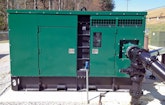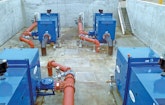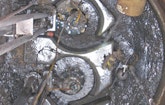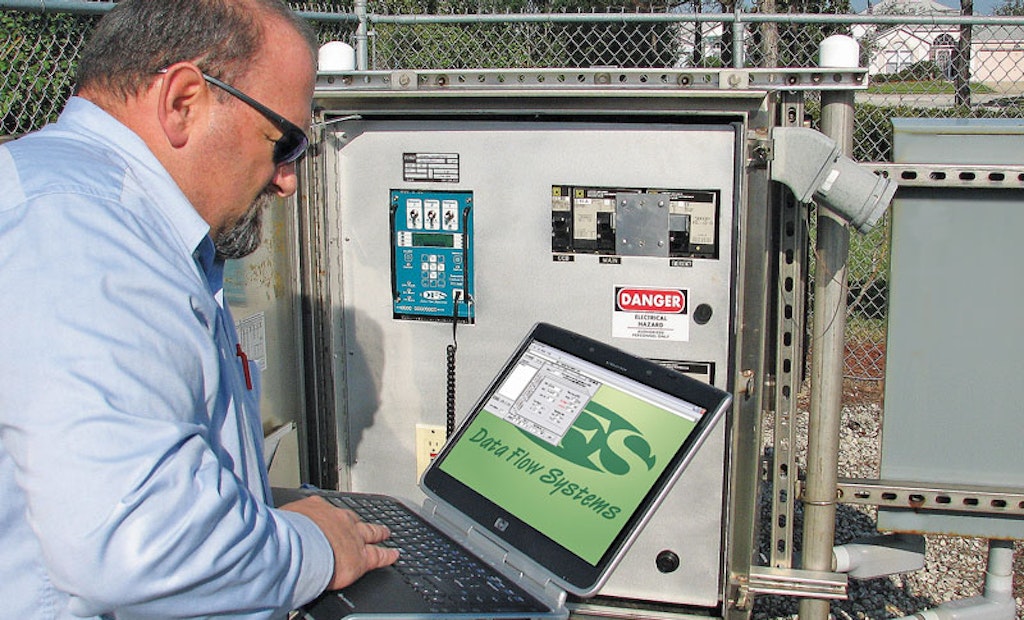Interested in Infrastructure?
Get Infrastructure articles, news and videos right in your inbox! Sign up now.
Infrastructure + Get AlertsManagement system solves pump run-time issues
Problem:
The city of Winter Park, Fla., was experiencing excessive pump run times and unacceptable pressures because of multiple lift stations pumping into a single force main.
Solution:
The city implemented Symphony - Harmonious Pump and Flow Management from Data Flow Systems. It coordinates systemwide operation of lift stations to reduce force main pressures and equalize flow. It corrects the random operation of stations and synchronizes pumping on a minute-by-minute basis.
Result:
The city saw diminished pump run times, lower maintenance and energy costs, fewer service calls and longer pump life. The system also resolved daily peak flow and pressure spikes. Research continues to improve the pumping algorithm. Initially, the system reduced average run-time reductions by 24 percent and energy costs by 39 percent. Recent run times are reduced 34 percent and energy costs 42 percent. 321/259-5009; www.dataflowsys.com.
Digesters eliminate grease and rag mats in pump stations
Problem:
The 3- to 12-foot-diameter pump stations along a 14-mile force main in Meridian, Miss., frequently had heavy grease and rag mats 2 to 3 feet thick, with hydrogen sulfide readings of over 900 ppm. The Meridian Sewer District sought a fix.
Solution:
At the advice of consultant Jim White, Hugh Smith, director of the Meridian Sewer District, installed 2 to 4 hp Little John Digesters from DO2E Waste Water Treatment in each pump station.
Result:
The grease and rag mats were completely eliminated within 24 hours, and hydrogen sulfide readings were reduced to less than 5 ppm after four weeks. There has been no reformation of grease, rags or hydrogen sulfide in the 11 months since the project was initiated. 251/626-6550; www.do2e.com.
Level controller provides solution for pump station call-outs
Problem:
Not long after startup in the two new lift stations, Rick McKinnon, public works supervisor for the Town of Eckville, Alberta, quickly became aware of problems as he began receiving call-outs from high-level alarms. They investigated and experimented with baffles and stilling wells, attempting to reduce the periodic buildup of foam and grease that likely was causing the ultrasonic sensor to lose echo loss in the pump stations.
Solution:
Carbon Controls recommended the Greyline Instruments PSL 5.0 Pump Station Level Controller. It was designed to operate both with a noncontacting ultrasonic sensor plus a generic 4-20 mA level signal from an alternate sensor. The transition from primary to secondary level signal is seamless and transfer to the secondary signal is displayed to the operator with usage hours logged for troubleshooting. Using the run-time reporting function, McKinnon can plan pump maintenance and spot pump problems before failures occur.
Result:
The municipality eliminated call-outs. Having an alternate monitoring method that is not defeated by foam or grease allows a second opinion in the case of a temporary loss of sonar signal without tripping the high-level alarms. 888/473-9546; www.greyline.com.
New SCADA system solves outdated software issues
Problem:
The city of Wolfforth, Texas, needed to retrofit its existing SCADA system for its water system because the original one was no longer stable or reliable as a result of municipal growth. The city often had to pay overtime hours to operators who manually operated equipment when the automation system required changes or servicing.
Solution:
Lubbock Electric Company was chosen to install the new SCADA system, and the company chose InduSoft Web Studio because it was affordable and very flexible, with over 240 native drivers. The new PC-based SCADA software was configured to provide real-time data access with user-friendly advanced graphic displays for the City’s water/wastewater system. Operators can configure their wells to start/stop at various levels. The SCADA system also provides extensive alarming features with alarm conditions that include door open, unauthorized intruder, pump start/stop failure, incorrect valve position, power failure, PLC failure and communication error.
Result:
Since the retrofit, the city has been pleased with the results, as the new automation system has been reliable. The system improved uptime as well as overall system performance, and has provided a superior return on investment. 877/463-8763; www.indusoft.com.
Chemical blocks used to clean FOG from lift stations
Problem:
A water/sewer district in South Carolina was losing prime in one of its main lift stations due to the excessive buildup of fats, oils and grease. Each morning the lead operator would go down to the lift station, backflow the pump to flush it out and re-prime it to get the pump cycling again. It turned out a nearby residential neighborhood was causing most of the problem. The neighborhood sewage drained into a smaller lift station that pumped to the larger one, where the pump was losing prime.
Solution:
Martech Research recommended treating the smaller lift station with two medium-sized FOG Blocks per week, while a single large block was added once a week to the larger main lift station.
Result:
Within a few days, the larger lift station was flowing freely with no further assistance. The grease cap had broken down and no longer was a problem to pump. After two weeks, the operator was able to pump the lift station to its lowest level to remove silt, sand and other settled materials from the system. The district still uses FOG Blocks to keep things flowing smoothly. 803/428-2000; www.martechresearch.com.
Pumping station provides aesthetic and biological benefit
Problem:
With the regulatory agency demand for constant pumping of return-to-source river water over a 24/7 basis, reliability on pump performance became the primary consideration for equipment selection at a private landscaping project near De Pere, Wis. Water taken from the Fox River is pumped through a decorative fountain and then returns to the river, at which point it’s considered a tributary. Aeration of the water brought about by the cascading design intrigued the agency and allowed the project to proceed.
Solution:
To meet these criteria, Sustainable Treatment Processes, August Winter and Sons and project manager Apple Valley Landscaping selected Pioneer Pump 4-inch self-priming units. The base-mounted duplex pumping station provided financial control over the operation and guaranteed pumping. Using one pump allowed for the featured waterfall effect, and with the second added, a grand waterfall.
Result:
These conditions met the expectations of everyone involved, and the return stream to the river may induce trout and salmon to return to the fishery. Current plays a significant role in attracting these aquatic species to spawning areas, which is why a no-flow condition cannot be tolerated. With the station provided, one pump is available at all times to ensure ongoing flow. 503/266-4115; www.pioneerpump.com.
Portable flowmeter enables city to track multiple valves
Problem:
A city in Colorado needed to determine the flow through each of their three separate valve chambers to determine whether the water load was shared equally among the valves. By measuring the flow rates, the operator is able to use the data to determine whether they need to adjust the pressure set points on any of the pressure reducing valves in each vault. As there was no power source and limited space in the station, the city specifically wanted a portable flowmeter that could be shared between three valves in the three separate chambers.
Solution:
Pipestone Equipment’s Dave Buchwald suggested Singer Valve’s SPI-MV, as the single point insertion probe can be inserted into a valve to measure flow and then be moved to a different valve. The insertion probe extends into the flow stream in one of the valve inlet connections and protrudes into the valve, equivalent to 1/8 of the valve diameter size. As a single piece design, the bullet nose profile has no moving parts to get clogged, and contains nothing to wear or break.
Result:
As the SPI-MV is accurate to 2 percent of reading throughout the specified velocity range, the city is now able to monitor the flow rates of their valves and compare loads to ensure equal flow. 888/764-7858; www.singervalve.com.
Resort town wipes out pump clog problems
Problem:
Consumer flushables were causing regular pump clogs in the year-round resort community of Big Bear City, Calif. “Nine times out of 10 when we pulled a pump it would be clogged with rags, just clogged full of them,” says Andy Keller, Sewer Department foreman, who estimated that the most problematic of the seven underground pump stations he operates was clogging as many as three to four times a week. Also contributing to the problem was the fluctuating population, which was known to quadruple on many weekends. Pump clogs would often come one right after another, and because many were on the weekends, overtime hours were paid to service workers.
Solution:
After consultation with a representative from manufacturer Smith & Loveless, the city purchased X-PELLER impellers for three problematic stations. The mono-port design helps to counterbalance hydraulic forces and create a balanced, single flow path that passes 3-inch solids and problem flushables.
Result:
Pump clogs have been virtually eliminated, according to Keller. Operation costs are down overall. Maintenance workers are freed up to work on other equipment, and they are safer day-in day-out with no more trips to the confined space of an underground station. 800/898-9122; www.smithandloveless.com.
Permanent backup lift station pumps create cost savings, control flooding
Problem:
The Mill Creek Pump Station is a recent effort by the City of Mt. Vernon, Ind., to limit combined sewer overflows into the Ohio River. The design conditions were 7,000 gpm at 78 feet TDH as specified by the Indiana Department of Environmental Management as part of a Long Term Control Plan implementation program. The job requires pumps that will operate in a temperature range of -40 to 125 degrees F. Communication between the pump station and the storage basin is critical to avoid flooding the storage basin.
Solution:
Thompson Pump & Manufacturing installed four sound-attenuated 18-inch pumps equipped with an Oil-less Vacuum Technology priming system for quicker priming times and designed to operate in sync with one another to coordinate a lead-lag effect, assuring that no one pump operates more frequently than the others. Each is sound attenuated to reduce operating noise levels below the EPA standard of 76 dBA at 7 meters, and is equipped with the Arctic Knight cold-weather package to allow it to continue operating in extreme temperatures. Transducers at the discharge site allow communication between the pumps and the storage basin to prevent overflow.
Result:
The pump performance has exceeded expectations. A notable cost savings was created as a result of utilizing diesel-driven pumps. 386/767-7310; www.thompsonpump.com.
Prerotation pumping system attacks lift station clogs
Problem:
The Allen Road Lift Station in Bakersfield, Calif., faced two problems: pumps that clogged and dirty wet wells full of floating and settled solids that caused an unpleasant odor. The temporary solution for clogged pumps required maintenance personnel to travel to the lift station to manually clean out the pumps. Hiring a vacuum truck on a regular basis was the sole solution for removal of the problematic floating and settled solids.
Solution:
The city selected a WEMCO-Hidrostal Prerotation pumping system, manufactured by Weir Specialty Pumps. It incorporates a prerotation basin designed to skim floatables from the top of the wet well and scour settled solids each time the pump runs through a pumping cycle. Simultaneously, it diminishes the problem of clogging pumps with the use of a single vane impeller. The system is designed to handle municipal sewage without clogging.
Result:
The systems were installed in 2007, and have not experienced a single clogged pump to date. Additionally, floating and settled solids have been eliminated and the regular vacuum truck visits have been reduced by more than 75 percent. 801/359-8731; www.weirsp.com.













